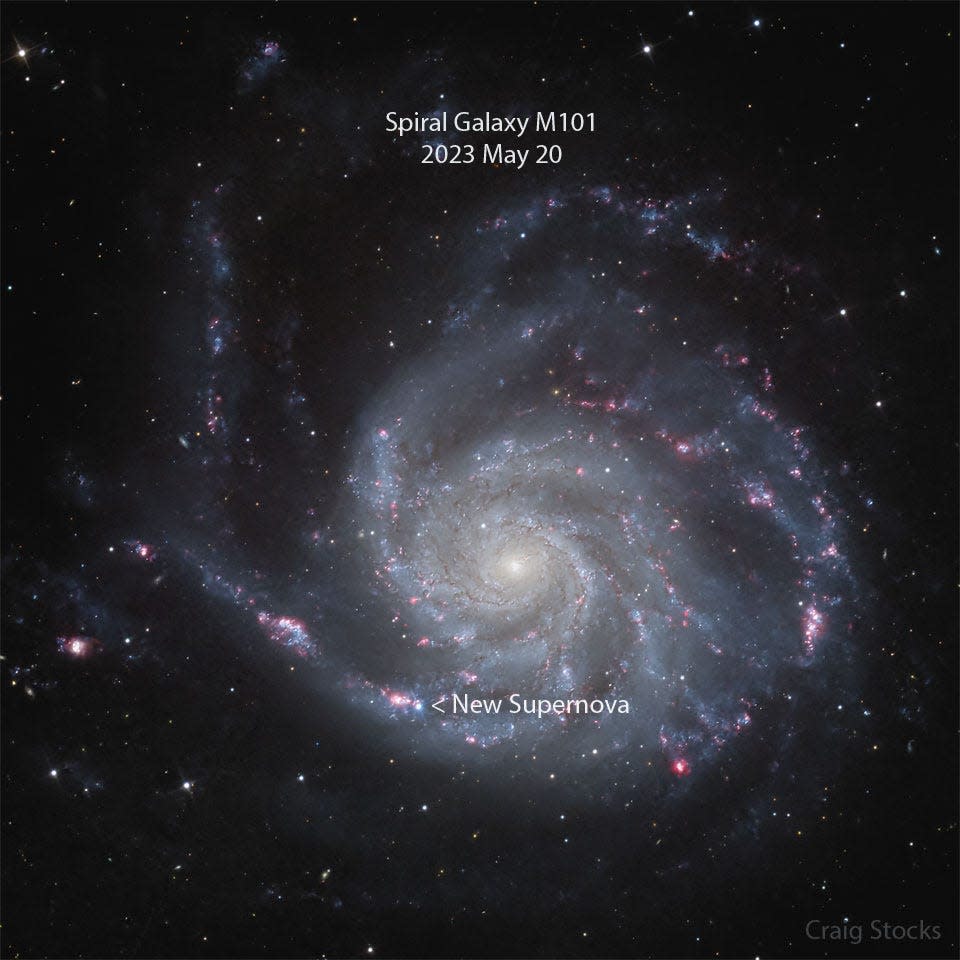A supernova 'only' 21 million light-years away has been spotted. Here's how you can see it.
Stargazers, rejoice: There's a new supernova in the night sky. Though not visible with the naked eye, the supernova is bright enough to see through a small telescope, according to Sky and Telescope magazine.
Space.com reports that "this new supernova has appeared in a galaxy beyond our own. The galaxy is known as the Pinwheel Galaxy (also designated as Messier 101, or M101), and is a large, loosely wound, spread-out, open-faced spiral galaxy which can be viewed through a small telescope."
The supernova, the second-closest to Earth in a decade, is dubbed SN 2023ixf by the International Astronomical Union. It was discovered by Japanese astronomer Koichi Itagaki four days ago.

How can I see the supernova?
The Pinwheel Galaxy is located the border separating Ursa Major (the Big Bear) from Boötes the Herdsman, Space.com said. "If you locate the Big Dipper, imagine a line extending from two of the stars in the handle, Alioth and Mizar. Continuing that line a similar distance beyond Mizar will place one in the general vicinity of the galaxy."
Fantastic discovery: 'We have seen what we thought was unseeable': First photo of a black hole revealed
A supergiant star exploded as a supernova in the prominent galaxy M101 in Ursa Major. It’s now bright enough to see in a 4.5-inch telescope! @AstroBob_bk https://t.co/MkXPjsUxAd pic.twitter.com/XZFkdXRu31
— Sky & Telescope (@SkyandTelescope) May 22, 2023
What is a supernova?
A supernova is the explosion of a star. It is the largest explosion that takes place in space, according to NASA. SN 2023ixf is a Type II supernova, an explosion that occurs after a massive star runs out of nuclear fuel and collapses.
The galaxy that contains the supernova is "only" about 21 million light-years away, NASA said, which makes it the closest supernova seen in the past five years, the second-closest in the past 10 years, and the second supernova found in M101 in the past 15 years.
The image above shows the galaxy two days ago with the supernova highlighted.
SN 2023ixf will probably brighten and remain visible to telescopes for months. Studying such a close and young Type II supernova may yield new clues about massive stars and how they explode, NASA said.
Star system to explode: Doomed 'pinwheel' star system to explode in spectacular gamma-ray blast, study says
Hubble is looking at the Ext Star SN2023IXF with Space Telescope Imaging Spectrograph (STIS/CCD) for Mr. Erez Zimmerman. https://t.co/slQjAKMxI1 pic.twitter.com/NnWkjtNhpA
— Space Telescope Live (@spacetelelive) May 22, 2023
🚨SUPERNOVA ALERT 🚨: SN2023ixf was just discovered a few hours ago in the Pinwheel Galaxy, M101! At 21 million light years away it’s the closest supernova in a decade- currently rising rapidly and should be viewable soon in amateur telescopes!https://t.co/IRT53TXFRS pic.twitter.com/UXulMeHiRX
— Yvette Cendes (@whereisyvette) May 20, 2023
This article originally appeared on USA TODAY: New supernova in the Pinwheel Galaxy now visible with a telescope

